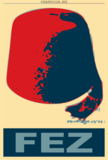Speaking March 20 to the City Club of Cleveland, Bush said Tal Afar once was “a key way station” for al-Qaida’s operations in Iraq, and the terrorist group soon returned to control the city after being driven out temporarily by coalition forces in September 2004.
The president said al-Qaida employed “deliberate and highly organized attempts to maintain control through intimidation,” sending a clear message to the citizens of Tal Afar that “anyone who dares oppose their reign of terror will be murdered.” As a result, the residents effectively became “prisoners in their own homes” until Iraqi and coalition forces recaptured the city in 2005, Bush said.
The president said the Iraqi government and coalition forces adopted a new approach called, “clear, hold and build,” in which terrorist forces would be driven out, trained Iraqi soldiers would remain in the city and the soldiers would “work with local leaders to build the economic and political infrastructure Iraqis need to live in freedom.
“This new approach was made possible because of the significant gains made in training large numbers of highly capable Iraqi security forces,” Bush said.
Tal Afar was one of the first tests of the new strategy, and Bush said the first step in its implementation was meeting with tribal leaders and local residents to listen to their grievances. That meeting resulted in the building of “a professional police force that all sides could have confidence in.”
Iraqi and coalition forces also began to win trust by careful focus on securing the safety of the population in their military operations against terrorists.
Tal Afar today is “a city that is coming back to life,” he said.
Or guys who actually know something about Iraq?
Juan Cole:
The US military used Kurdish and Shiite troops to attack the northern Turkmen city of Talafar in August. Kurdish troops, drawn from the Peshmerga militia, were allowed to paint lasers on targets in the city, which were then destroyed by the US air force. Entire neighborhoods were destroyed, and much of the population was displaced for some time. Shiite troops and local Shiite Turkmen informants were used to identify and interrogate alleged Sunni insurgents. Turkey was furious at the attack on ethnically related Turkmen and threatened to halt its cooperation with the US. Although the attack was allegedly undertaken to capture foreign forces allegedly based in the city, only 50 were announced apprehended. The entire operation ended up looking like a joint Kurdish-Shiite attack on Sunni Turkmen, backed by the US military. Turkmen and Kurds do not generally get along, and Turkmen accuse Kurds of wanting to ethnically clense them from Kirkuk. The entire operation was politically the worst possible public relations for the US in northern Iraq, and seems unlikely to have put a signficant dent in the guerrillas' capabilities.
Paul Rieckhoff:
But that is not the whole story. The truth is that coalition forces re-took the city in September because they lost control of it in 2004 due to inadequate Troop numbers (CBS story). And after the US forces retook the city, Al Qaeda fighters escaped Tal Afar and unleashed twelve suicide bombers in Baghdad - an attack they claimed publicly as revenge for Tal Afar. This illustrates perfectly why fighting the insurgency in Iraq has become like a game of Whack-a-Mole.
Tal Afar is a good story today, but who knows where it will be a year from now. And that is one of the biggest problems we face in Iraq right now. We can not hold the ground we take. In 2007, I might be writing about troops re-re-taking Tal Afar.
WWJD?
What Would Jonah do?
Then I'll do the opposite.
 Rising Hegemon
Rising Hegemon
No comments:
Post a Comment